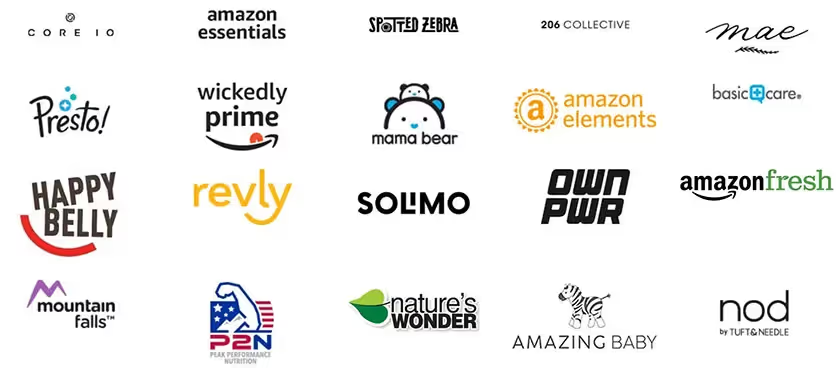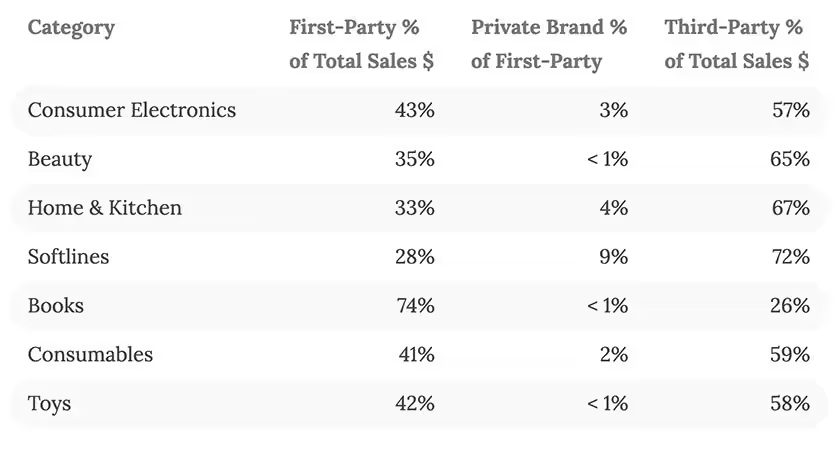The Complete Guide to Amazon’s Private Label Brands
What are Amazon’s private label brands and how do they affect your product listings? Learn the history of, and how to compete with Amazon’s private label brands.
It’s a scenario every retail shopper is familiar with: you find the name-brand product that you’ve been looking for when, to your delight, you find an almost identical store-brand product on the same aisle for a fraction of the price. If you aren’t particularly attached to the name-brand item, or if the product’s price is the most important consideration in your purchasing decision, you may choose to buy the store-brand product.
Store brand products, or private label products, are those manufactured by a third party and sold under a retailer’s name. Typically, these products are sold alongside their name-brand counterparts for a lower price. Some of the most familiar private label brands include Walmart’s Great Value brand, Target’s Mainstays brand, and Costco’s Kirkland Signature brand. Grocery store brands are among the most recognizable private labels, but department stores also make a significant number of sales on their own private brand clothing.
While private label brands aren’t new by any means—retailers have created private label products since the mid-19th century—they’re uncharted territory on online retailers and marketplaces like Amazon. This unfamiliarity makes it difficult for consumers to recognize private labels online and even more difficult for brands to compete with the low prices.
Amazon owns over 100 private label brands that operate in dozens of markets on its site, including food and beverage, automotive, clothing, and electronics. Similarly to private label brands we see in brick-and-mortar stores, Amazon brands often create products similar to name-brand best-sellers on the site and sell them for a low price.
Amazon bills its products as high-quality and lists them at some of the lowest prices online. While that may be great news for consumers looking to save a dime, it’s made Amazon the subject of intense scrutiny and concerns of both government entities and third-party sellers. If you’re a third party seller on Amazon’s site, we’re here to tell you everything you need to know about Amazon’s private label brands and how to compete with them.

A brief history of Amazon’s private label brands
Amazon introduced its first in-house brands—AmazonBasics and Pinzon, which both sell everyday household goods—in 2009. Only in the past few years, however, has the company ramped up its focus on private label creation. In 2017, there were just 30 private label brands in operation on the site compared to more than 100 today.
Some of Amazon’s brands are widely recognizable, like Echo or Kindle, but most aren’t as easy to spot. Amazon has listed about two dozen of their brands on its “Our Brands” page, and many of its product listings are labeled with “Amazon Brand” in the name or description so it’s easy to identify them. That said, details about all of Amazon’s private labels are fairly limited.
Why Amazon’s brands concern third-party merchants
While Amazon claims its private label products make up about 1% of its total sales, its sales in specific categories have grown rapidly. According to Numerator, brands selling in Amazon’s core consumer packaged goods (CPG) category—household, grocery, baby, pet, beauty, and health products—saw an 81% growth in the 2017 to 2018 time period.
AmazonBasics has seen major growth in recent years. As of April 2020, the label had been growing at a steady 47% year over year for the past 12 months. Indeed, in Jeff Bezos’ July 29 hearing with Congress, he shared the following statistics about Amazon private label brands. While these brands make up less than 1% in the category, MarketplacePulse reported, they make up to 9% of sales (in clothing).


Screenshots from MarketplacePulse Of course, this is nothing when compared to big-box retailers like JC Penney or Macy’s, who project that their private label clothing brands make up anything between 70% and 25% of clothing sales, respectively.
However, Amazon’s increase in sales has come with an increase in seller unease. According to our 2019 marketplace survey we conducted among ecommerce executives, Amazon’s private label brands are a top concern—73% of survey respondents say they are concerned with Amazon’s private label products competing with their own, and 57% of those indicated that they are very concerned. Sellers aren’t the only ones concerned—Elizabeth Warren called out Amazon last April for “tilt[ing] the online marketplace in its own favor” by selling private label brands.
A few months after Sen. Warren’s remarks, The Washington Post found Amazon had featured several of its branded products as “similar items to consider” when customers clicked to add an item of higher cost to their cart (e.g. AmazonBasics batteries were offered to shoppers looking for Energizer batteries).
At the start of 2020, Amazon appeared to be quietly removing similar features that could raise concerns about anti-competitive behavior, but there is still cause for concern. Between April 2018 and April 2020, the number of AmazonBasics best-seller products alone jumped from 660 to over 1,300, with AmazonBasics eating up prime real estate in certain search results pages.
Recent controversy from Amazon's private brands
Amazon has been the subject of several antitrust investigations in the past year. Historically, they’ve denied using sellers’ data to unfairly skew the market in their favor, but in a recent Congressional hearing, chief executive Jeff Bezos testified that he could not confirm Amazon didn’t use data it collects about products sales in its marketplace to launch its own private-label goods.
“What I can tell you is we have a policy against using seller-specific data to aid our private-label business,” Bezos said. “But I can’t guarantee you that policy has never been violated.”
In the hearing, Bezos was questioned about a seller who claimed Amazon created an identical product to their own and sold it at a far lower price, causing their sales to plummet overnight. It isn’t the first time Amazon’s been accused of copycat behavior that causes brands to CRaP out.
In November 2019, Allbirds co-CEO Joey Zwillinger called out Amazon for selling shoes under its 206 Collective label that look exactly like Allbirds’ Wool Runner shoes. The listing price for Amazon’s copycat product was $45, half the price of Allbirds’ shoes.
Amazon claimed in an October 2020 letter that an internal investigation into third-party sales data found no violations of the policy Bezos testified about a few months prior. This investigation—which only looked at two products—wasn’t enough to please the U.S. House Judiciary antitrust subcommittee, which released a report acknowledging the letter but maintaining that Amazon uses competing sellers’ third-party data to unfairly bolster its private-label business.
Despite the ongoing controversy and concern from brands, there seems to be limited legal basis for complaints against Amazon’s private labels, besides cases of copyright infringement.
It’s not unusual for retailers to use third party sales data to develop and market competing products. And while brands may be upset to see low-priced Amazon versions of their products suggested on their listing pages, this practice is similar to what we see in brick-and-mortar stores—Great Value breakfast cereals, for example, are usually placed next to their brand-name counterparts on Walmart’s shelves.
Just like is the case with other major retailers and their private labels, it’s unlikely that Amazon private label products will go away. Competing with these inexpensive products, and potentially even dealing with Amazon’s copycat versions of your products, is one of many costs of selling on Amazon. Instead of trying to make these products go away, brands should focus on their marketing and product quality so their product is still worth buying for consumers despite a slightly higher price.
How your brand can compete with private label brands
If you’re a third-party merchant selling products on Amazon, you may feel intimidated by the prospect of competing with Amazon. The good news is there are several practices that can help.
Since low prices are the main draw of Amazon private label products, most of Amazon’s brands have had limited exposure on their site and elsewhere on the web. The priority of private labels isn’t to win their consumers over with high-quality marketing and a strong brand story—it’s to sell the cheapest products possible to consumers who value low prices.
Because of this, Amazon products don’t have the same level of brand recognition as other companies, which means customers are generally less likely to trust them over another brand they’ve heard of or had good experiences with. Sharing your brand’s story and nurturing customer trust by providing exceptional customer service and high quality products is how your brand can stand out above private labels.
Marketing
In your marketing content and listing optimization, be sure to highlight the features that make your product unique from similar, cheaper private-label products. Maybe your product is made from higher-quality materials or more ethically made than its private label counterparts. Focus on the features that both set you apart from private label products and that are important to your audience. Knowing and researching your consumer base is key when creating marketing that will convince shoppers to pick your product over a more basic, cheaper version.
Gear and bag company Peak Design is a great example of such marketing. In March 2021, Peak Designs released a video that humorously outlined the differences between one of its products, the Everyday Sling, and a similar one sold by Amazon Basics of the same name.
The video—which has been viewed almost 5 million times—acknowledges the similarities between the two bags while also emphasizing its own design’s desirable features like fairly paid factory workers, carbon neutrality, a lifetime warranty, and high-quality, recycled materials.
In addition to these tips, implementing best-practices for SEO for Amazon that drive outside web traffic to your products and providing product listings that are easy to understand and engaging can help your brand compete.
Customer Service
Beyond product development and marketing, customer service can also play a role in convincing consumers to choose your brand over an Amazon brand. Exceptional customer service creates a chain reaction that can lead customers to leave positive reviews and push your content to areas on Amazon where it has greater visibility.
Product Variation
Another thing you can do is create new variations of the products you’re already selling with their own ASIN. One example is making your product part of a bundle so it’s different from similar products Amazon may sell.
Shipping and Fulfillment
It may also be helpful to research dropshipping vs. FBA when it comes to your shipping model. It’s becoming increasingly difficult to compete with Amazon’s fast shipping times, and for many sellers, FBA may be the best choice. Your brand will be more equipped to compete with Amazon’s private label products if you can ship products just as quickly and reliably as products sold by Amazon.
In addition to the fast shipping benefits, fulfilling your product orders with FBA can help give your brand more credibility and exposure than it would receive otherwise, especially since using FBA qualifies your products for Amazon Prime.
Ready to take on the competition? Pattern’s ecommerce experts can help you create a strategy to compete against Amazon’s private label brands.


.jpg)





.jpg)

